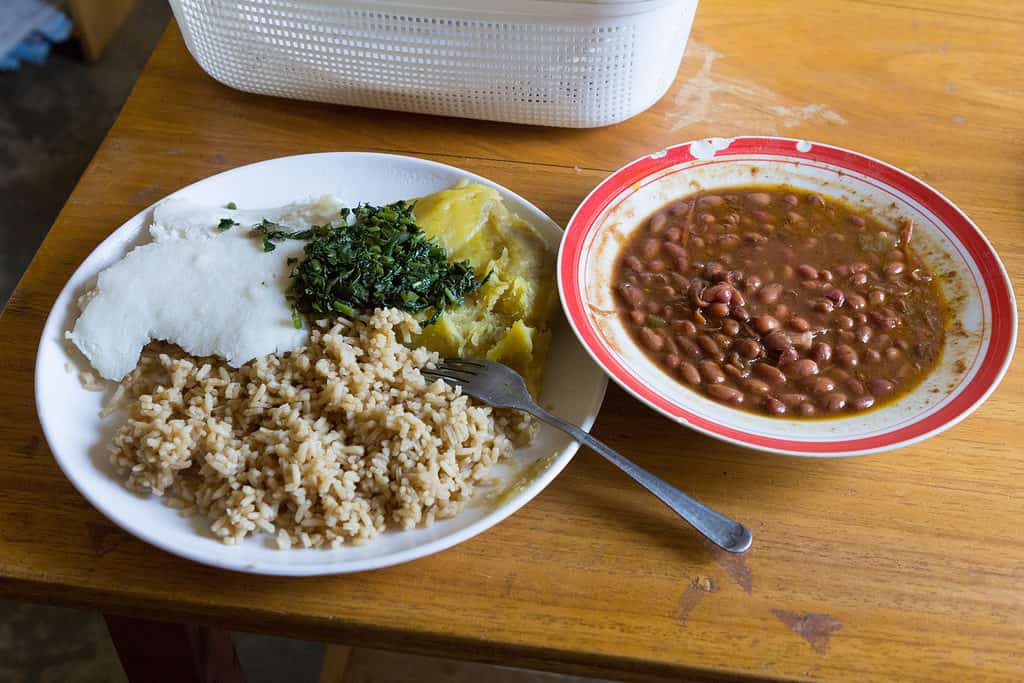Uganda is the Republic of Uganda officially. It is a country in East Africa and a part of the African Great Lakes region, with Lake Victoria located in the southern part of Uganda. The total area of Uganda is 93,065 square miles, and nearly 46 million people live there. The largest city in Uganda is Kampala, the capital city, with a population of 8.5 million.
Uganda gets its name from the kingdom of Buganda, which is located within the country. The word Uganda is Swahili for Buganda. The kingdom of the Buganda people is a large traditional kingdom with a long and extensive history. They were unified in the 13th century under King Kato Kintu and have grown to one of the largest states in East Africa.
Uganda: Languages, Geography and Cuisine

Uganda is known for posho and matooke, both common meals in the country.
©Adam Jan Figel/Shutterstock.com
The official language in Uganda is English, but over 70 languages are commonly spoken in the country. More than 10 million people speak Lugandan, a Bantu language of the African Great Lakes region. Instructors teach Swahili as a mandatory subject in schools.
The geography of Uganda is diverse and includes the Ruwenzori Mountain range, which has a height of 16,712 feet. Uganda is landlocked but contains many lakes, including Lake Victoria, one of the world’s biggest lakes.
English, Arab, and Indian cuisines influence Uganda’s food, which includes staples such as potatoes, yams, bananas, and tropical fruits. Common meals are posho, which is a maize meal, and matooke, from steamed and mashed green bananas. Ugandan people also make a delicious bread from millet.
Uganda: Economy, Government, and Religion
The currency of Uganda is the Shilling, and the economy of Uganda is on the rise. Fifty-six percent of the economy is supported by agriculture, especially coffee. The country has a large exportation trade and sells coffee, oil, metal, fish, corn, cement, tobacco, tea, sugar, cocoa beans, and many other products. Uganda also has a large reserve of natural gas and crude oil. Despite these resources, Uganda remains one of the poorest nations in the world, with nearly 40 percent of its citizens living on $1.25 per day.
Uganda is a presidential republic with the president acting as head of state and the prime minister acting as head of government business. Uganda is a democracy with a multi-party system.
Freedom of religion is a guaranteed right in the constitution of Uganda. According to a 2014 census, 84 percent of citizens in Uganda identify as Christian and 14 percent identify as Muslim.
The Flag of Uganda: Description

The flag of Uganda features the grey-crowned crane, one of the nation’s birds.
©Tatohra/Shutterstock.com
The flag of Uganda has six horizontal stripes of equal size. The top stripe is black, followed by yellow, red, black, yellow again, and a final stripe of red at the bottom. In the center of the flag is a white disc. Inside the white circle is a grey-crowned crane facing left. This crested crane is grey, black, yellow, and red, and it is the national symbol of Uganda.
The Flag of Uganda: Symbolism
The three colors of the flag are each symbolic. The black stands for the people of Africa, the yellow stripe stands for the sun shining brightly over the country, and the red stripe stands for the blood that connects the country’s many people. The crane in the middle has been the symbol of Uganda since the colonial period. It has one leg raised to show continual forward progress by the nation and the people.
Independence Day in Uganda
Citizens celebrate Independence Day as a state holiday every year on October 9th. Celebrations throughout the country include music, festivals, and performances. In Kampala, at the Kololo Ceremonial Grounds, a military parade commemorates the day. This celebration consists of a speech by the President of Uganda, a marching band, singing of the national anthem, and prayers for the nation.
Flag of Uganda: Variations
1914-1962
The first flag of Uganda was designed in 1914 when the area was a British colony. It depicted a British blue ensign defaced with the Union Jack in the upper right-hand corner. To the right, sat a crowned crane in gray, black, white, and yellow. This flag was neutral to avoid favoritism toward any one kingdom.
1962 March to October
Since Uganda left the British Empire, there have been two flags. The political party that ruled at the time designed it. It showed a central bank in blue, edged in thin yellow stripes and thicker green stripes. The blue bank showed a pure yellow crane standing on one leg.
1962-Current
The second flag is the current national flag flown today and has been in place since October 9th, 1962.
NEXT UP…
- The Flag of Mexico: History, Meaning, and Symbolism
- The Ukrainian Flag: History, Meaning, and Symbolism
- The Flag of the United States of America: History, Meaning, and Symbolism
The photo featured at the top of this post is © Osman Bugra Nuvasil/Shutterstock.com
Sources
- Data World Bank, Available here: https://data.worldbank.org/indicator/SI.POV.DDAY
- population.un.org, Available here: https://population.un.org/wpp/
- Web Archive.org, Available here: https://web.archive.org/web/20061210003812/http://www.bunyoro-kitara.com/history2.htm#The%20Babiito
- Uganda Mission, Available here: https://www.ugandamission.net/aboutug/symbols.html
- CRW Flags, Available here: https://www.crwflags.com/fotw/flags/ug-bugan.html#61
Thank you for reading! Have some feedback for us? Contact the AZ Animals editorial team.






